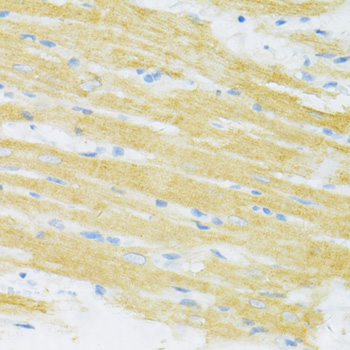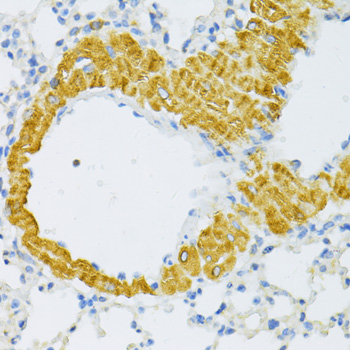Immunology Antibodies 2
Anti-TYROBP Antibody (CAB5385)
- SKU:
- CAB5385
- Product Type:
- Antibody
- Reactivity:
- Mouse
- Reactivity:
- Rat
- Host Species:
- Rabbit
- Isotype:
- IgG
- Antibody Type:
- Polyclonal Antibody
- Research Area:
- Immunology
Description
| Antibody Name: | Anti-TYROBP Antibody |
| Antibody SKU: | CAB5385 |
| Antibody Size: | 20uL, 50uL, 100uL |
| Application: | IHC |
| Reactivity: | Mouse, Rat |
| Host Species: | Rabbit |
| Immunogen: | Recombinant fusion protein containing a sequence corresponding to amino acids 1-113 of human TYROBP (NP_003323.1). |
| Application: | IHC |
| Recommended Dilution: | IHC 1:50 - 1:200 |
| Reactivity: | Mouse, Rat |
| Positive Samples: |
| Immunogen: | Recombinant fusion protein containing a sequence corresponding to amino acids 1-113 of human TYROBP (NP_003323.1). |
| Purification Method: | Affinity purification |
| Storage Buffer: | Store at -20'C. Avoid freeze / thaw cycles. Buffer: PBS with 0.02% sodium azide, 50% glycerol, pH7.3. |
| Isotype: | IgG |
| Sequence: | MGGL EPCS RLLL LPLL LAVS GLRP VQAQ AQSD CSCS TVSP GVLA GIVM GDLV LTVL IALA VYFL GRLV PRGR GAAE AATR KQRI TETE SPYQ ELQG QRSD VYSD LNTQ RPYY K |
| Gene ID: | 7305 |
| Uniprot: | O43914 |
| Cellular Location: | Membrane, Single-pass type I membrane protein |
| Calculated MW: | 11kDa/12kDa |
| Observed MW: |
| Synonyms: | TYROBP, DAP12, KARAP, PLOSL |
| Background: | This gene encodes a transmembrane signaling polypeptide which contains an immunoreceptor tyrosine-based activation motif (ITAM) in its cytoplasmic domain. The encoded protein may associate with the killer-cell inhibitory receptor (KIR) family of membrane glycoproteins and may act as an activating signal transduction element. This protein may bind zeta-chain (TCR) associated protein kinase 70kDa (ZAP-70) and spleen tyrosine kinase (SYK) and play a role in signal transduction, bone modeling, brain myelination, and inflammation. Mutations within this gene have been associated with polycystic lipomembranous osteodysplasia with sclerosing leukoencephalopathy (PLOSL), also known as Nasu-Hakola disease. Its putative receptor, triggering receptor expressed on myeloid cells 2 (TREM2), also causes PLOSL. Multiple alternative transcript variants encoding distinct isoforms have been identified for this gene. |
| UniProt Protein Function: | TYROBP: Non-covalently associates with activating receptors of the CD300 family. Cross-linking of CD300-TYROBP complexes results in cellular activation. Involved for instance in neutrophil activation mediated by integrin. Defects in TYROBP are a cause of polycystic lipomembranous osteodysplasia with sclerosing leukoencephalopathy (PLOSL); also called presenile dementia with bone cysts or Nasu-Hakola disease (NHD). PLOSL is a recessively inherited disease characterized by a combination of psychotic symptoms rapidly progressing to presenile dementia and bone cysts restricted to wrists and ankles. PLOSL has a global distribution, although most of the patients have been diagnosed in Finland and Japan, with an estimated population prevalence of 2x10(-6) in the Finns. Belongs to the TYROBP family. 2 isoforms of the human protein are produced by alternative splicing. |
| UniProt Protein Details: | Protein type:Membrane protein, integral; Cell surface Chromosomal Location of Human Ortholog: 19q13.1 Cellular Component: cell surface; integral to plasma membrane; plasma membrane Molecular Function:identical protein binding; protein binding; receptor signaling protein activity; receptor binding Biological Process: integrin-mediated signaling pathway; axon guidance; regulation of immune response; neutrophil activation during immune response; macrophage activation during immune response; innate immune response; cellular defense response; signal transduction Disease: Polycystic Lipomembranous Osteodysplasia With Sclerosing Leukoencephalopathy |
| NCBI Summary: | This gene encodes a transmembrane signaling polypeptide which contains an immunoreceptor tyrosine-based activation motif (ITAM) in its cytoplasmic domain. The encoded protein may associate with the killer-cell inhibitory receptor (KIR) family of membrane glycoproteins and may act as an activating signal transduction element. This protein may bind zeta-chain (TCR) associated protein kinase 70kDa (ZAP-70) and spleen tyrosine kinase (SYK) and play a role in signal transduction, bone modeling, brain myelination, and inflammation. Mutations within this gene have been associated with polycystic lipomembranous osteodysplasia with sclerosing leukoencephalopathy (PLOSL), also known as Nasu-Hakola disease. Its putative receptor, triggering receptor expressed on myeloid cells 2 (TREM2), also causes PLOSL. Multiple alternative transcript variants encoding distinct isoforms have been identified for this gene. [provided by RefSeq, Mar 2010] |
| UniProt Code: | O43914 |
| NCBI GenInfo Identifier: | 7531221 |
| NCBI Gene ID: | 7305 |
| NCBI Accession: | O43914.1 |
| UniProt Secondary Accession: | O43914,Q6FGA5, Q9UMT3, A8K2X0, F5H389, |
| UniProt Related Accession: | O43914 |
| Molecular Weight: | 113 |
| NCBI Full Name: | TYRO protein tyrosine kinase-binding protein |
| NCBI Synonym Full Names: | TYRO protein tyrosine kinase binding protein |
| NCBI Official Symbol: | TYROBP |
| NCBI Official Synonym Symbols: | DAP12; KARAP; PLOSL |
| NCBI Protein Information: | TYRO protein tyrosine kinase-binding protein; KAR-associated protein; DNAX-activation protein 12; killer-activating receptor-associated protein |
| UniProt Protein Name: | TYRO protein tyrosine kinase-binding protein |
| UniProt Synonym Protein Names: | DNAX-activation protein 12; Killer-activating receptor-associated protein; KAR-associated protein |
| Protein Family: | TYRO protein tyrosine kinase-binding protein |
| UniProt Gene Name: | TYROBP |
| UniProt Entry Name: | TYOBP_HUMAN |
View AllClose








